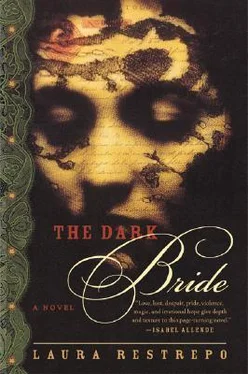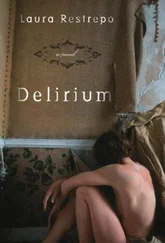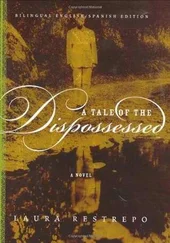“My heart shriveled when I entered that place,” she tells me. “Claire was one of those who earned the most from her work; she saved what she earned and had become a rich woman. If she didn’t live like a queen it was because she didn’t want to, and because she always believed that she was here temporarily.”
Despite having lodged Claire for a dozen years, the little room was still a poor and transient-looking place, with scarcely any furnishings. Not a single animal, not a single plant, nothing incompatible with the desolate impersonality of a boardinghouse, nothing that couldn’t be packed up from one moment to the next, nothing that would involve delays when it was time to leave.
“Afterward, tying up loose ends, we came to a realization. Not even the train’s passing could cure Claire of the broken promise that was always strangling her, like a hand pressing on her throat,” Todos los Santos recalls. “During the ten years Claire had lived in Colombia she agonized under false hope; now we know for certain that there was no other motive that pushed her toward her end.”
From time to time throughout those ten years of anxiety and waiting they would hear her sigh for a certain Mariano, who, however, had never been seen in Tora. They all suspected that Claire languished in a distracted haze because she had given her heart to this Mariano. Rumors of him arrived, but he never did. His letters, staggered, also arrived, inside fine envelopes of Kimberly paper with Claire’s name and address handwritten in sepia ink and beautiful nineteenth-century script; and the rumor circulated through the pueblo that he sent his lover funds in the form of money orders.
“Yes, there were money orders, but they weren’t from him to her, it was the reverse,” clarifies Fideo, as she travels in her hammock as if on a riverboat.
“How’s that?”
“Just as it sounds. It was Claire who sent money to Mariano in the capital to support his electoral campaigns, because he was a politician.”
According to the news that Mistinguett had spread around, with who knows what basis, Claire left her native France and came to America in the footsteps of this man, who had promised to marry her one spring night on the Pont des Arts. But clearly it was not her who he finally married, as the women of La Catunga would learn on the day of Claire’s funeral.
The beautiful French woman was mourned, like so many fellow prostitutas who had died before her, in the red hall of the Dancing Miramar, surrounded like a bride by carnations and tapers; the face — miraculously spared by the impact and still beautiful — was enveloped in the silk lace veil; definitive was the paleness of her death and delicate the shadow cast by her eyelashes on her cheeks of soft Sevres porcelain, like that depicted on the postcard sent by Sacramento.
Except for Sayonara, who wasn’t anywhere to be found, all of La Catunga was there, accompanying in grief someone who had died by her own hand and far from her homeland. The main hall of the Miramar — with its rows of mirrors, its Venetian chandeliers, its red and black velvet upholstery — in the semidarkness of midnight glistened dreamlike and splendid like a salon at Versailles, but beneath the indiscreet intrusion of the sun, it had more the look of a real funeral parlor: sad, faded, dusty, and airless.
The Dancing Miramar — doubly promiscuous? — was the unique and shared precinct for the rites of love and the rites of death, and not by choice but for lack of another alternative. Save for a few veterans, like Todos los Santos or Olguita, who were owners of houses with plots of land, the other women had only minuscule rooms in a jumble of precarious and collective buildings, with a common bath and kitchen. And those cubicles, which could scarcely hold a bed, certainly had no room for even a tenth of the huge crowd that generally appeared at funerals.
On the other hand, by decree of the parish priest, not even a dead prostitute, literally speaking, could enter the church, which provided an opportunity for La Negra Florecida, owner of the Dancing Miramar, who charged each girl ten pesos a night to dance in her establishment and snag clients, and a hundred and twenty for a funeral service, taking into account that the latter fee was paid only once. She made it available only during the day and as part of the deal she provided the tapers, the candelabras, black coffee in little cups for the ladies, rum in discreet quantities for the gentlemen, a sign at the entrance with a black emblem and the name of the deceased written in gothic letters, along with four dozen white, sweet-smelling flowers.
That afternoon, as they mourned Claire, those present witnessed the arrival of an imposing funeral wreath, the size of a truck wheel, into which at least two hundred roses of spectral whiteness had been intertwined and across which was a purple cloth ribbon with gold letters reading: MARIANO AZCÁRRAGA CABALLERO Y SEÑORA. The girls of La Catunga read the pompous name and were left breathless; fifteen months earlier Mariano Azcárraga Caballero, electoral baron of high caliber and kingpin of the reigning political party, had been elected senator. And “Señora”? Three months earlier there had been news of the existence of that wife, by way of the daily newspaper El Tiempo , which published a photograph of her on her wedding day with the same Mariano in whom Claire had deposited, until that day of irreparable sorrow and supreme anguish, all of her faith, her hope, and the better part of her charity.
“That’s what she got for not mistrusting power, which is always poisonous and treacherous and disdainful of people,” notes Fideo from the sidelines.
Dragging her trailing legs and bearing the wreath, Olguita approached Claire and placed it at her feet.
“Your Mariano wants you to know that he’s with you at the hour of your death,” she said quietly, rearranging a lock of limp, blond hair.
The Dancing Miramar no longer exists, but La Negra Florecida does and today she’s the mother, grandmother, and great-grandmother of a tribe of men and women who are university graduates. She is very ill from an intestinal infection that they call, as she told me, the seventeen types of fecal material, and when I asked her, most likely with a look of surprise on my face, to repeat the name of her illness, she told me that if I didn’t believe her she would show me the lab results, to which I quickly responded that that would not be necessary, that I had really come to ask her about something else.
“A hundred twenty pesos per dead person wasn’t much to charge,” she told me, “if you take into account that after the funeral I had to pay a rezandero to cleanse the place, because it would be contaminated after four or five hours of sheltering a tearful, moaning crowd. Around here there has always been a belief that after a funeral the walls are still in grief. If they aren’t cleaned no one will want to come back at night to fall in love, sing, and laugh.”
The Dancing Miramar: dual shelter of love and of death? No, an entire universe, and threefold, like the Trinity: birth, love, and death.
“I didn’t just take care of death,” La Negra Florecida told me, looking at me through her glasses, thick as the bottom of a bottle, as the seventeen types of fecal material ravaged her intestines. “I also handled births: I had set up a delivery room on the second floor, because there were many girls who ended up pregnant. When the time came I sent someone to fetch Cuatrocientos, who helped with the deliveries.”
On her way to Claire’s funeral, Todos los Santos stopped at her house to get Sayonara, but she couldn’t find the girl. She asked around the block if anyone had seen her, but no one had. Claire was buried at sunset in a field where cows were grazing, free of crosses or tombstones, removed from the village and at the edge of the Río Magdalena, a place they called the Other Cemetery. It was there, with no shelter other than a flight of herons and no monument other than a weeping willow, that suicide victims, masons, unbaptized babies, women who had had abortions, and prostitutas went to find eternal rest — all unredeemable sinners to whom the priests refused burial in the Cementerio Mayor. At least with the double stigma of prostitution and suicide, Claire’s unlucky star marked her for exile in death, just as it had in life.
Читать дальше












